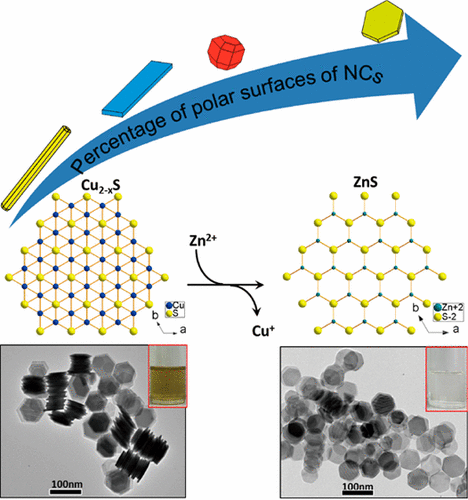当前位置:
X-MOL 学术
›
J. Phys. Chem. Lett.
›
论文详情
Our official English website, www.x-mol.net, welcomes your
feedback! (Note: you will need to create a separate account there.)
Dominant Polar Surfaces of Colloidal II-VI Wurtzite Semiconductor Nanocrystals Enabled by Cation Exchange.
The Journal of Physical Chemistry Letters ( IF 4.8 ) Pub Date : 2020-06-04 , DOI: 10.1021/acs.jpclett.0c01372 Aixiang Wang 1 , Wenjie Wang 1 , Jiayi Chen 2 , Rundong Mao 2 , Yingping Pang 2 , Yunguo Li 3 , Wei Chen 2 , Dechao Chen 2 , Derek Hao 4 , Bing-Jie Ni 4 , Martin Saunders 5 , Guohua Jia 2
The Journal of Physical Chemistry Letters ( IF 4.8 ) Pub Date : 2020-06-04 , DOI: 10.1021/acs.jpclett.0c01372 Aixiang Wang 1 , Wenjie Wang 1 , Jiayi Chen 2 , Rundong Mao 2 , Yingping Pang 2 , Yunguo Li 3 , Wei Chen 2 , Dechao Chen 2 , Derek Hao 4 , Bing-Jie Ni 4 , Martin Saunders 5 , Guohua Jia 2
Affiliation

|
Polar surfaces of ionic crystals are of growing technological importance, with implications for the efficiency of photocatalysts, gas sensors, and electronic devices. The creation of ionic nanocrystals with high percentages of polar surfaces is an option for improving their efficiency in the aforementioned applications but is hard to accomplish because they are less thermodynamically stable and prone to vanish during the growth process. Herein, we develop a strategy that is capable of producing polar surface-dominated II–VI semiconductor nanocrystals, including ZnS and CdS, from copper sulfide hexagonal nanoplates through cation exchange reactions. The obtained wurtzite ZnS hexagonal nanoplates have dominant {002} polar surfaces, occupying up to 97.8% of all surfaces. Density functional theory calculations reveal the polar surfaces can be stabilized by a charge transfer of 0.25 eV/formula from the anion-terminated surface to the cation-terminated surface, which also explains the presence of polar surfaces in the initial Cu1.75S hexagonal nanoplates with cation deficiency prior to cation exchange reactions. Experimental results showed that the HER activity could be boosted by the surface polarization of polar surface-dominated ZnS hexagonal nanoplates. We anticipate this strategy is general and could be used with other systems to prepare nanocrystals with dominant polar surfaces. Furthermore, the availability of colloidal semiconductor nanocrystals with dominant polar surfaces produced through this strategy opens a new avenue for improving their efficiency in catalysis, photocatalysis, gas sensing, and other applications.
中文翻译:

通过阳离子交换实现的胶体II-VI纤锌矿型半导体纳米晶体的主要极性表面。
离子晶体的极性表面在技术上正变得越来越重要,这对光催化剂,气体传感器和电子设备的效率产生了影响。具有高百分比极性表面的离子纳米晶体的产生是用于提高其在上述应用中的效率的一种选择,但是由于其热力学稳定性较差并且在生长过程中易于消失,因此难以实现。本文中,我们开发了一种能够通过阳离子交换反应从硫化铜六角形纳米板生产极性表面主导的II–VI半导体纳米晶体(包括ZnS和CdS)的策略。所获得的纤锌矿型ZnS六角形纳米板具有占优势的{002}极性表面,占所有表面的97.8%。在阳离子交换反应之前存在阳离子缺陷的1.75 S六角形纳米板。实验结果表明,可通过极性表面主导的ZnS六角形纳米板的表面极化增强HER活性。我们预计该策略是通用的,可以与其他系统一起使用以制备具有优势极性表面的纳米晶体。此外,通过该策略生产的具有优势极性表面的胶体半导体纳米晶体的可用性为提高其在催化,光催化,气体传感和其他应用中的效率开辟了一条新途径。
更新日期:2020-07-02
中文翻译:

通过阳离子交换实现的胶体II-VI纤锌矿型半导体纳米晶体的主要极性表面。
离子晶体的极性表面在技术上正变得越来越重要,这对光催化剂,气体传感器和电子设备的效率产生了影响。具有高百分比极性表面的离子纳米晶体的产生是用于提高其在上述应用中的效率的一种选择,但是由于其热力学稳定性较差并且在生长过程中易于消失,因此难以实现。本文中,我们开发了一种能够通过阳离子交换反应从硫化铜六角形纳米板生产极性表面主导的II–VI半导体纳米晶体(包括ZnS和CdS)的策略。所获得的纤锌矿型ZnS六角形纳米板具有占优势的{002}极性表面,占所有表面的97.8%。在阳离子交换反应之前存在阳离子缺陷的1.75 S六角形纳米板。实验结果表明,可通过极性表面主导的ZnS六角形纳米板的表面极化增强HER活性。我们预计该策略是通用的,可以与其他系统一起使用以制备具有优势极性表面的纳米晶体。此外,通过该策略生产的具有优势极性表面的胶体半导体纳米晶体的可用性为提高其在催化,光催化,气体传感和其他应用中的效率开辟了一条新途径。











































 京公网安备 11010802027423号
京公网安备 11010802027423号